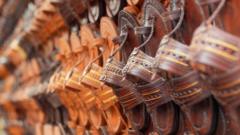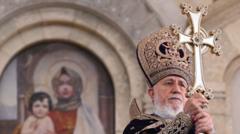The cardinal-electors are set to cast their votes in the Sistine Chapel, adhering to centuries-old practices for selecting the next leader of the Roman Catholic Church.
**A New Era for the Vatican: Cardinal Voting Process Unveiled**

**A New Era for the Vatican: Cardinal Voting Process Unveiled**
As the papal conclave begins, traditions and sacred objects guide the election of the next pope.
The conclave to select the next pope is officially in session at the Vatican, with cardinals ready to engage in a time-honored voting process. Each cardinal, who plays a key role in the governance of the Roman Catholic Church, will vote through a secret ballot until one candidate achieves the necessary two-thirds majority. The inner workings of this sacred assembly remain confidential, but the traditions and specific items utilized during the conclave give insight into this significant event.
During the conclave held in the Sistine Chapel, the voting takes place at simple wooden tables, governed by the stipulations set out in the Universi Dominici Gregis (U.D.G.). A central feature of the room is an urn designed to collect the ballots — these rectangular papers inscribed with “Eligo in Summum Pontificem” meaning “I elect as Supreme Pontiff.” Each cardinal will write their chosen candidate's name on these ballots before depositing them into the urn for counting.
In a bid for accountability, the process also involves wooden balls marked with numbers that correspond to the total attendance of cardinals. As ballots are counted, an attendant will remove one ball for each ballot cast to ensure that the number of ballots matches the number of cardinals present. Should there be an inconsistency, the ballots are discarded, and a new vote must be held immediately, ensuring the integrity of the election process.
This conclave not only represents a pivotal moment for the Catholic Church but also reflects a confluence of tradition and modern governance, making it a profound event watched by millions worldwide.
During the conclave held in the Sistine Chapel, the voting takes place at simple wooden tables, governed by the stipulations set out in the Universi Dominici Gregis (U.D.G.). A central feature of the room is an urn designed to collect the ballots — these rectangular papers inscribed with “Eligo in Summum Pontificem” meaning “I elect as Supreme Pontiff.” Each cardinal will write their chosen candidate's name on these ballots before depositing them into the urn for counting.
In a bid for accountability, the process also involves wooden balls marked with numbers that correspond to the total attendance of cardinals. As ballots are counted, an attendant will remove one ball for each ballot cast to ensure that the number of ballots matches the number of cardinals present. Should there be an inconsistency, the ballots are discarded, and a new vote must be held immediately, ensuring the integrity of the election process.
This conclave not only represents a pivotal moment for the Catholic Church but also reflects a confluence of tradition and modern governance, making it a profound event watched by millions worldwide.



















